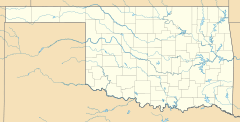Carpenter, Oklahoma facts for kids
Quick facts for kids
Carpenter, Oklahoma
|
|
|---|---|
| Country | United States |
| State | Oklahoma |
| Counties | Roger Mills / Custer |
| Elevation | 1,946 ft (593 m) |
| Time zone | UTC-6 (Central (CST)) |
| • Summer (DST) | UTC-5 (CDT) |
| GNIS feature ID | 1090986 |
Carpenter is a small, unincorporated community located in the state of Oklahoma, United States. It sits partly in Roger Mills County and partly in Custer County. An unincorporated community is a place that doesn't have its own local government, like a city or town. Instead, it's governed by the county or state.
This community is about eight miles north of a larger town called Elk City, Oklahoma.
Contents
How Carpenter Got Its Name
Carpenter was named to honor Benjamin Carpenter. He was an early settler who moved to western Oklahoma in 1898 from Texas. He was a local rancher, meaning he owned and managed a large farm for raising livestock.
The First Post Office
The community officially started when a Post Office was opened there on March 19, 1901. Having a Post Office was a very important step for a new community. It meant people could send and receive mail, which connected them to the rest of the country. This helped the community grow and become more established.
Where is Carpenter Located?
Carpenter is in the western part of Oklahoma. This area is known for its wide-open spaces and agricultural land. The community's location across two counties is interesting. It shows how settlements can sometimes grow right on the borders of different administrative areas.
Geography and Surroundings
The land around Carpenter is mostly flat or gently rolling. It's part of the Great Plains region of the United States. The elevation of Carpenter is about 1,946 feet (593 meters) above sea level. This means it's quite high up compared to sea level.
Life in an Unincorporated Community
In an unincorporated community like Carpenter, daily life can be different from a big city. There might not be a mayor or a town council. Local services like roads or schools are often managed by the county government. This type of community often has a close-knit feel.



